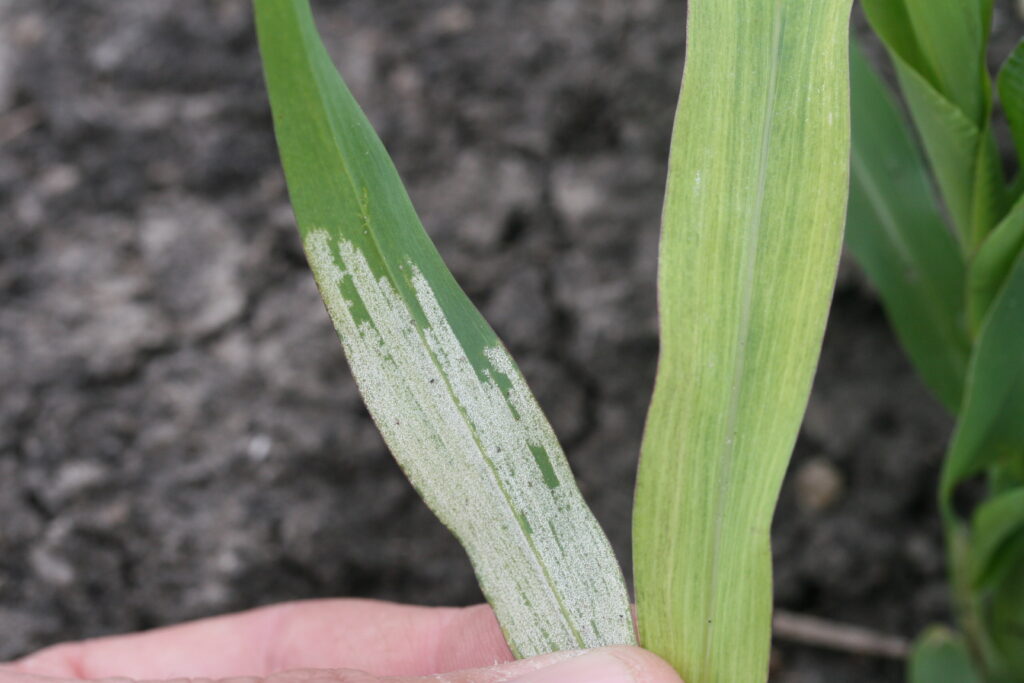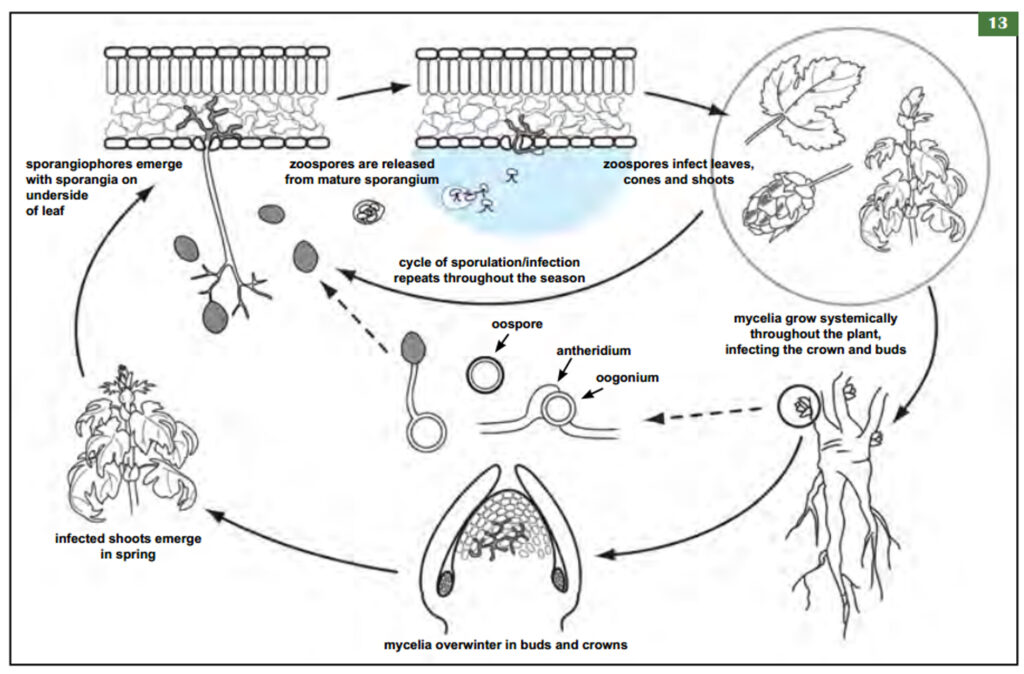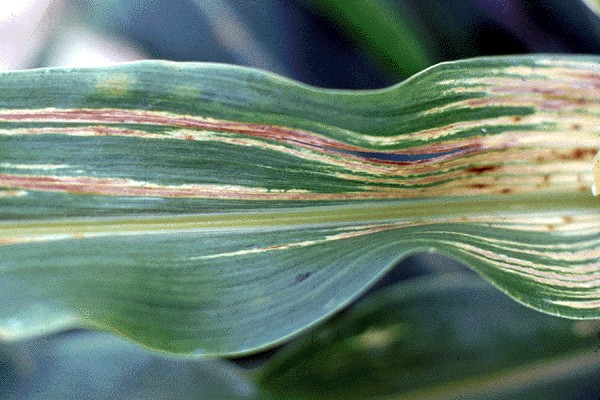Sorghum downy mildew, caused by a fungus named Peronosclerospora sorghi, is a significant fungal disease that affects sorghum and maize plants. Downy Mildew disease is present all around the world, particularly in warm areas like the tropics and subtropics. It has the potential to lead to a reduction in crop yield, sometimes even by as much as 30% or higher.
Symptoms of Downy Mildew of Sorghum

- The fungus responsible for sorghum downy mildew causes a widespread and systemic infection in sorghum plants.
- The infection occurs by invading the growing points of young plants, either through oospore or conidial infection pathways.
- As the young leaves begin to unfold, they display a coloration ranging from green to yellow.
- On the lower surface of these leaves, an abundant growth of downy white structures appears. These structures consist of sporangiophores and sporangia.
- Initially, about three or four leaves display this chlorotic downy growth.
- Subsequent leaves progressively exhibit a more pronounced symptom – complete bleaching of leaf tissue in streaks or stripes.
- As the affected bleached leaves mature, they become necrotic, and the tissue between the veins disintegrates.
- This disintegration releases the resting spores (oospores), while the vascular bundles become loosely connected. This leads to the characteristic shredded leaf appearance.
Also Read: Covered Kernel Smut Sorghum: Symptoms, Management
Disease Cycle of Sorghum Downy Mildew: How It Spreads and Grows

- Local Spread and Long-Distance Possibility:
- The fungus responsible for sorghum downy mildew can spread within a local area through spores carried in the air.
- The disease could also potentially travel longer distances by hitching a ride on infected seeds or soil contaminated with spores.
- Primary Infection and Oospores:
- The first step in the disease cycle involves a type of spore called “oospores,” which reside in the soil.
- These oospores are the initial culprits. When they germinate, they kickstart a systemic infection within the plant.
- Interestingly, these oospores can remain hidden in the soil for many years, waiting for the right opportunity to cause trouble.
- Secondary Spread via Air:
- Once the oospores have done their job, the disease doesn’t stop there. It continues to spread.
- This time, the culprit is “air-borne sporangia.” These tiny structures can travel through the air, aiding the disease in moving from plant to plant.
- Mycelium in Seeds:
- The fungus is cunning – it also hides within the seeds of plants it has already infected systemically.
- This means that even new plants grown from these seeds can start their life already carrying the disease.
- Collateral Host Involvement:
- The disease cycle of Downy Mildew doesn’t always rely solely on sorghum. It can sometimes use a different host plant to survive and thrive.
- This collateral host is called “Heteropogen centortus.” The fungus can maintain itself on this host, even if it’s not its primary target.
- Tissue Breakdown and Shredding:
- As the disease progresses, it causes the breakdown of the plant’s tissue. This leads to the distinctive symptom of shredded leaves.
- The oospores produced by the fungus can end up in two places: on the ground or carried by the wind, often within pieces of infected tissue.
- Longevity of Oospores:
- These oospores are tough survivors. They can stay viable in the soil for quite a while, anywhere from 5 to 10 years.
- Nighttime Conidia Formation:
- The fungus doesn’t rest. At night, it goes into production mode, forming a large number of spores called “conidia.”
- The best conditions for this production are when the temperature hovers around 20 to 23 degrees Celsius.
Also Read: Head Smut of Sorghum: What Is It, Symptoms, Management
Downy Mildew of Sorghum Management:
Preventing Method:
Izumonas-Best Fungicide
Contents: Pseudomonas Fluorescens
IZUMONAS is a biological product consisting of plant growth-promoting rhizobacteria (PGPR), which are naturally occurring bacteria found widely in nature. This unique product is designed to enhance plant defence mechanisms and promote healthy growth. IZUMONAS can be used on all types of crops without leaving any residue on the plants.
Izumil-Best Fungicide
Contents:
- Extract of Streptomyces griseus: 30%
- Extract of Streptomyces violaceus: 40%
- Dissolving agents: 30%
IZUMIL is a remarkable biotech research product that has been developed to activate the natural defence mechanism of plants. By using IZUMIL, plants can better protect themselves against fungal pathogens, improve their physiological functions, and develop resistance against various harmful microorganisms. Similar to IZUMONAS, IZUMIL can be safely used on all crops without leaving any residue.
Modes of Use:
- Seed Treatment: Mix 5-10 ml of IZUMONAS and IZUMIL per kilogram of seeds in an adequate amount of water. Submerge the seeds in this solution and allow them to dry in a shaded area before sowing.
- Seedling Treatment: Combine 100 ml of IZUMONAS and IZUMIL per 20 litres of water. Dip the roots of the seedlings in this solution for approximately 30 minutes prior to transplanting.
- Soil Application: Mix 500 ml of IZUMONAS and IZUMIL with 30 kilograms of farmyard manure (FYM) or soil. Apply this mixture to one acre of land before ploughing or irrigation.
- Foliar Application: Dilute 2-3 ml of IZUMONAS and IZUMIL each in 1 litre of water. Use this solution to spray the entire foliage of the plants, ensuring complete coverage on both sides of the leaves. It is advisable to shake the bottle before use. For best results, spray early in the morning or evening. If a power sprayer is used, double the recommended dosage.
Cultural Method:
- Crop rotation with other crops viz., pulses and oilseeds.
- Avoid the secondary spread of the disease by roguing out the infected plants since the
wind plays a major role in the secondary spread of the disease. - Grow moderately resistant varieties like Co25 and Co26.
- Seed treatment: Treat sorghum seeds with fungicides before planting to eliminate or reduce the presence of the pathogen.

